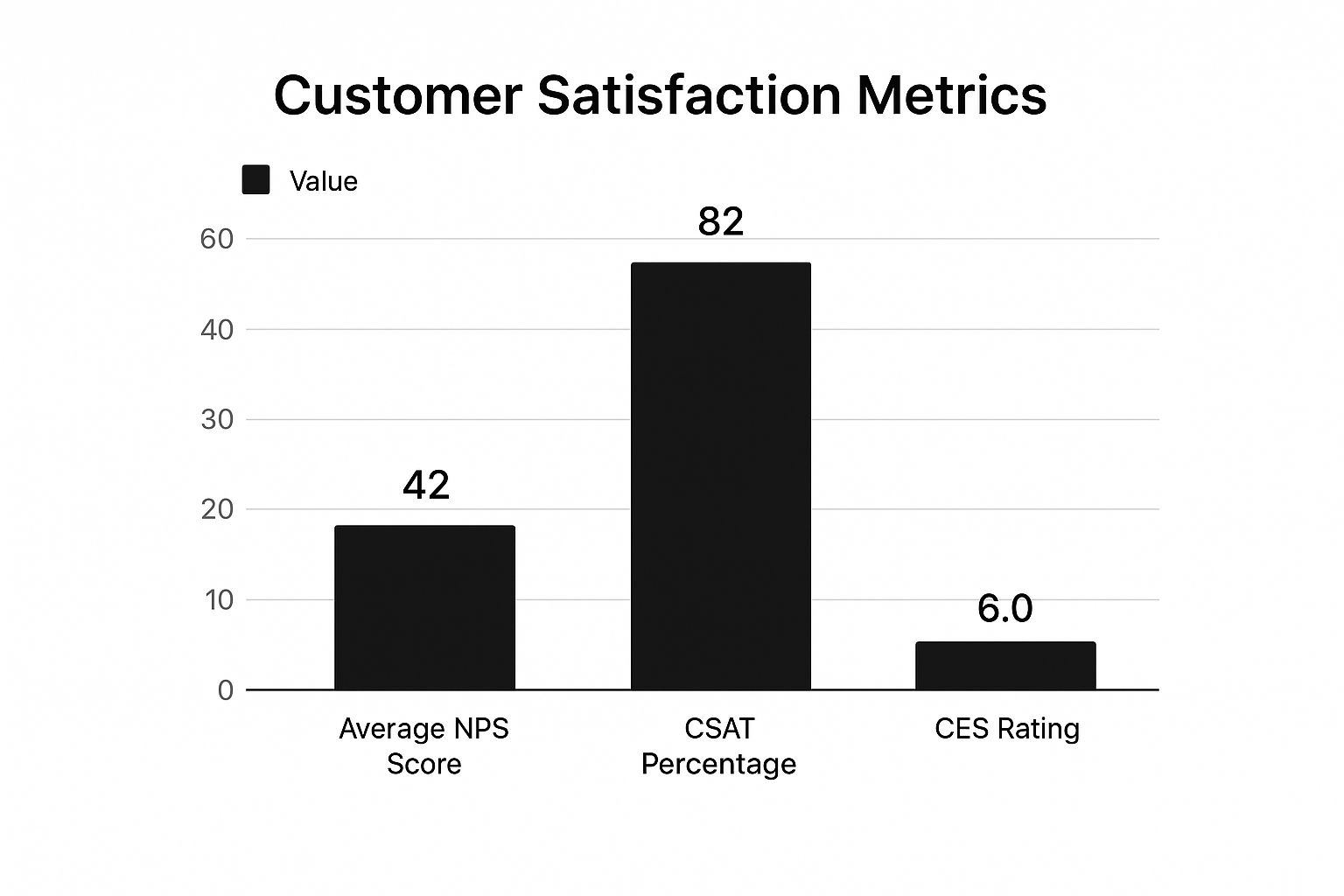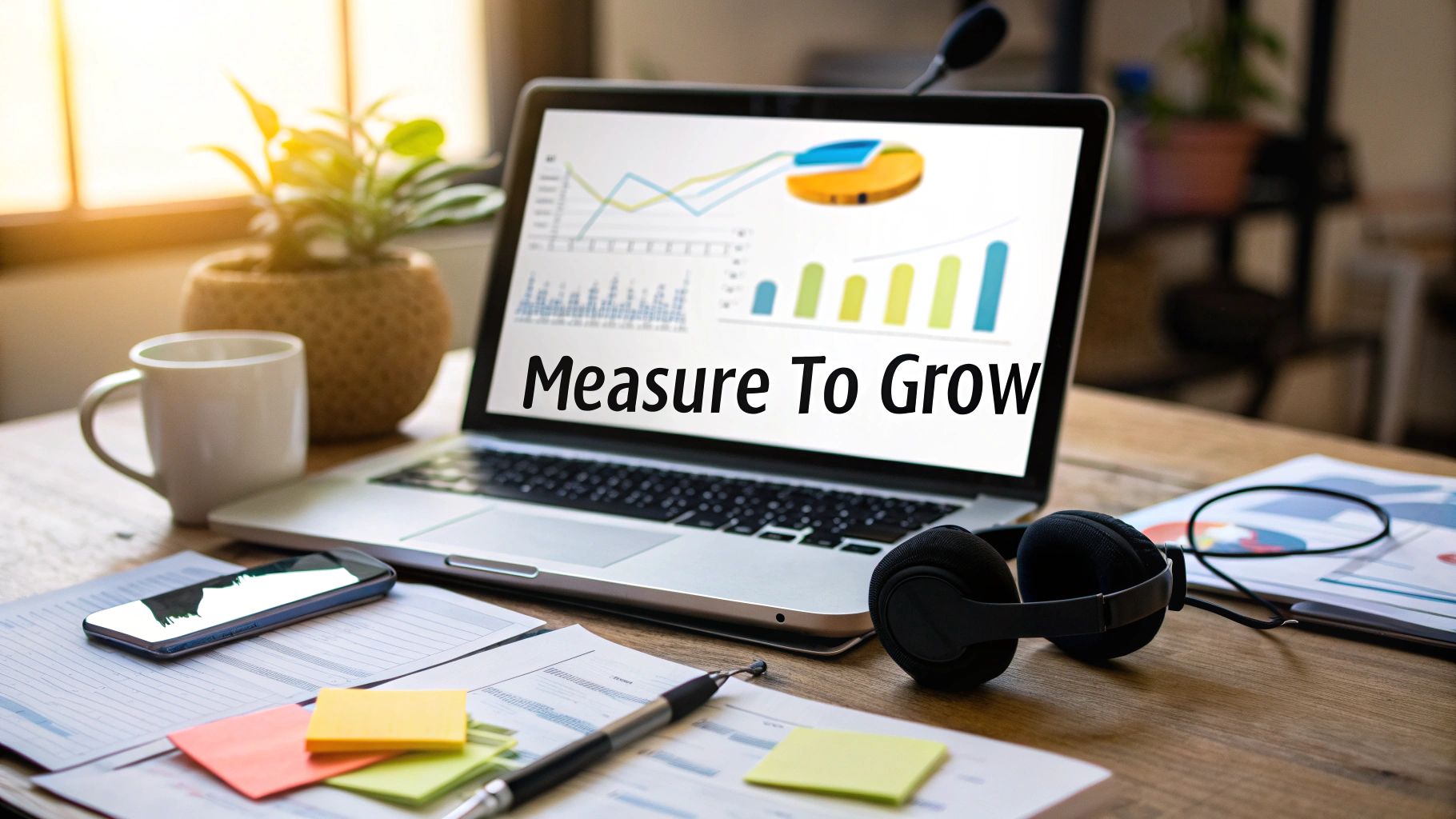Why Your Satisfaction Surveys Are Lying to You
Here's the thing: most companies aren't measuring customer satisfaction correctly. They’re collecting data that leads to bad decisions. Those generic five-star surveys? They might be giving you a false sense of security. I've talked to countless CX pros who completely overhauled their approach after realizing their old methods were masking serious problems.
One major culprit is response bias. Who’s actually filling out those surveys? Usually, it's the super happy or the super frustrated customers. Everyone in between—the ones who might quietly disappear next month—they often stay silent. This skews your data and hides potential churn risks.

This SurveyMonkey resource highlights how important good survey design is. So many businesses skip this crucial step and end up with biased results. Without carefully worded questions and targeted distribution, your surveys won't capture the full picture of customer sentiment.
Another common mistake? Focusing on individual interactions instead of overall customer loyalty. A customer might give a support call five stars, but still be totally annoyed with your product. You need to understand how customers feel about your brand as a whole. Exploring different customer satisfaction measurement methods can really help uncover deeper issues impacting their long-term relationship with you.
Plus, customer satisfaction measurement is constantly changing, particularly in the AE region. Personalization and data are key. Companies are using data analytics to create hyper-personalized experiences. Think neo-banks tailoring financial products based on transaction data, or luxury hotels like Jumeirah crafting bespoke travel experiences. Even public sector entities like Riyadh Municipality are using citizen feedback for urban planning, and companies like Etisalat are leveraging it to improve customer support. For more on this, check out this article on customer experience trends in the Middle East. And this piece on Customer Experience Management Framework might be helpful too.
So, your current surveys might be telling you something, but they’re probably not telling you everything. They might even be leading you astray. It's time to rethink your feedback process and make sure it truly reflects what your customers think and, more importantly, what they’ll do next.
Building Feedback Systems That Feel Natural
Getting customer feedback shouldn't feel like pulling teeth. It should be a natural part of your interactions with them. Forget intrusive pop-ups and generic email blasts. Instead, think about weaving feedback opportunities into the customer journey so they feel organic and valuable.
It's like asking a friend for their opinion – you pick the right time and place, right?

The infographic above visualizes key metrics: average NPS score, CSAT percentage, and CES rating. These give you a snapshot of customer perception. Notice the NPS score? While CSAT and CES are strong, NPS suggests we could boost customer loyalty. This is why using multiple metrics is key for a complete picture.
Integrating Feedback Seamlessly
Timing is everything. Don't blast customers with surveys right after a purchase. Trigger them at key moments—after a support interaction, or a product milestone. Just like people have different personalities, some prefer quick polls, while others enjoy detailed, open-ended surveys.
Offer variety! Email, SMS, in-app messages, or even a feedback button on your website. And don't forget the importance of a well-designed survey. A great guest experience survey can make all the difference. Check out this resource on creating one: guest experience survey.

This Zendesk screenshot shows a help desk interface. Platforms like these are gold mines for tracking and managing feedback, especially when integrated with your CRM. This centralizes customer data for a more holistic view of customer sentiment.
Reducing Survey Fatigue and Increasing Response Rates
No one likes endless surveys. Make feedback valuable, not a burden. Offer incentives: early access to features, or discounts. Keep surveys short, focused, and be transparent about how you're using the feedback.
Most importantly, respond to the feedback—even the negative comments. It shows you value their input. In fact, enhancing the customer experience is a huge priority, especially in the Middle East and Africa. The market for customer experience testing and monitoring solutions is set to explode, growing at a CAGR of 27.8% from 2025 to 2030! That's a jump from $210.3 million in 2024 to $816.2 million by 2030. It just goes to show how important this is becoming. Want to learn more about this growing market? Take a look here.
Let's talk tables. The table below compares different ways to collect feedback, looking at response rates, data quality, implementation costs, and the best scenarios for each.
To get the most out of your feedback systems, make them feel like a natural part of the conversation. That way, you'll gather valuable insights without annoying your customers.
Feedback Collection Methods Comparison
Comparing different feedback collection channels, their response rates, data quality, and implementation costs.
| Method | Response Rate | Data Quality | Implementation Cost | Best Use Case |
|---|---|---|---|---|
| In-app Surveys | High | High | Low | Gathering contextual feedback within the product |
| Email Surveys | Medium | Medium | Low | Reaching a broad audience |
| SMS Surveys | High | Low | Medium | Quick feedback on specific interactions |
| Social Media Polls | Low | Low | Low | Gauging general sentiment |
| Phone Calls | Medium | High | High | In-depth feedback and relationship building |
Key takeaway: In-app surveys offer the best balance of high response rates and data quality at a low cost, while phone calls provide richer insights but are more expensive. Choosing the right method depends on your specific needs and context.
Finding Metrics That Predict Real Business Outcomes
Net Promoter Score (NPS). It's everywhere. But sometimes, I've found it's not the best indicator of what really matters for a business: revenue growth, customer retention, and ultimately, long-term value. It’s so easy to get caught up in those "vanity metrics," the ones that look great on a slide deck but don't actually translate into real-world success. So, let's talk about some customer satisfaction metrics that actually do correlate with positive business outcomes.

This screenshot from Salesforce really nails it – understanding your customer's needs and building your strategy around them is paramount. That’s how you build strong relationships and create loyal customers.
Beyond the Buzz: Metrics That Matter
One metric I've found incredibly helpful is Customer Effort Score (CES). It measures how much work a customer has to do to get their problem solved. A high CES is a red flag. It usually means there's friction in the customer journey, and friction leads to customers heading for the exit.
Then there’s the Customer Health Score. I think of this as a more holistic view. It brings together different data points – things like product usage, how engaged they are, and their interactions with your support team. It paints a much clearer picture of the overall customer relationship.
Another metric that often gets overlooked is sentiment velocity. This tracks how quickly customer sentiment is shifting – positive or negative. A sudden swing, even if the overall sentiment is still positive, can be an early warning signal that something's not quite right. This might be something you find interesting: Contact Center KPIs.
Balancing the Quantitative and Qualitative
Now, while these quantitative metrics are invaluable, never underestimate the power of good old-fashioned qualitative feedback. Think open-ended survey responses, social media comments, and online reviews. They give you the rich context and nuanced insights that numbers just can't. For example, a low CES score tells you there's friction, but qualitative feedback tells you precisely where the friction is and why it's happening.
I've seen this in action. At one company, we found a seemingly insignificant website glitch was causing major frustration during checkout. The quantitative data (high CES) alerted us to a problem, but the qualitative feedback (customer comments specifically mentioning the glitch) showed us exactly what needed fixing. Addressing that one little glitch had a huge impact on conversions.
The following table provides an overview of key customer satisfaction metrics:
| Customer Satisfaction Metrics Guide | Overview of key satisfaction metrics, their calculation methods, benchmarks, and when to use each metric |
|---|---|
| Metric | Calculation |
| — | — |
| Net Promoter Score (NPS) | (% of Promoters) – (% of Detractors) |
| Customer Effort Score (CES) | Average effort score on a scale (e.g., 1-7) |
| Customer Satisfaction Score (CSAT) | % of satisfied customers |
| Customer Churn Rate | # of customers lost / total # of customers |
This table summarizes key satisfaction metrics and provides a starting point for choosing the right ones for your business.
The bottom line? Choose metrics that align with your business model and customer lifecycle. For an e-commerce company, things like conversion rate and cart abandonment rate might be more important than NPS. For a SaaS company, customer churn and lifetime value are key.
By zeroing in on the metrics that really predict business outcomes, you can ditch the vanity metrics and start making data-driven decisions that actually fuel growth.
Choosing Technology That Works With Your Team
Measuring customer satisfaction shouldn't be this huge, daunting task. The right tech can actually transform it from a dreaded chore into something that’s, well, almost enjoyable. Seriously, I’ve seen it happen. Smart companies use tools like their CRM systems, customer experience platforms, and analytics tools to create programs that people actually use.
Remember, the goal is to build a system that gives you valuable insights without creating extra work for your team.
Integrating Feedback Without the Headaches
Think of your tech stack as a finely tuned engine. All the parts need to work together. You want to integrate feedback data with your existing systems—your CRM, your marketing automation platform—without creating isolated data silos that no one can access. It happens more than you’d think.
One of the biggest mistakes I see is over-complicating things. Companies invest in these fancy, expensive tools, and then they just sit there gathering dust because they’re too complex. Keep it simple! Choose solutions that are intuitive and easy to integrate. Your team will thank you.
This screenshot from HubSpot is a great example of a clean, user-friendly CRM interface. A well-designed CRM is essential for centralizing customer data, which makes it so much easier to track interactions and analyze satisfaction trends. The key takeaway here is visual clarity. Information is presented in a way that's digestible and actionable.
Automating the Routine, Preserving the Human Touch
Automation can be a real game-changer, but it's not a magic bullet. Use it to handle the repetitive stuff, like sending out surveys and compiling basic reports. This frees up your team to focus on the things that really matter.
But remember, technology can't replace human insight. You still need your team to analyze the data, identify trends, and—most importantly—understand what the numbers mean. Data without context is just noise. When you're trying to predict real business outcomes, tracking customer service performance indicators is incredibly helpful.
For example, I worked with a company that automated their post-call surveys. It was a simple change, but it made a huge difference. Their customer service team suddenly had more time to focus on complex issues and build stronger customer relationships. They were happier, and so were their customers.
Choosing Solutions That Grow With You
When choosing technology, always think long-term. Select solutions that can scale with your business and adapt to your changing needs. Look for platforms that offer flexible integrations, robust reporting, and excellent customer support.
It’s also important to keep an eye on industry trends. For instance, the CRM market in the Middle East and Africa is expected to reach $9,049.3 million by 2030. This growth is driven by CRM adoption in key sectors like retail, which already held a 23.3% revenue share in 2024. You can find more insights here. This just goes to show how important it is to manage customer relationships effectively.
The right technology can empower your team to measure customer satisfaction efficiently and effectively, turning data into actionable insights that drive real business results. Don't let your tools become shelfware; choose tech that works for you, not against you.
Turning Data Into Stories That Drive Action
Raw satisfaction data is like a pile of bricks—you can’t build anything useful without a plan. It needs to be transformed into actionable insights, into stories that resonate with your team and drive real change. This is how you turn feedback into a compelling business case that gets attention and resources.

This screenshot from Tableau shows the power of data visualization. Dashboards like this make complex data digestible and highlight key trends related to customer behavior and satisfaction. See how clearly those visualizations communicate the data? That's the level of clarity you need to inspire action.
Identifying Meaningful Trends
I've seen businesses completely overhaul their operations just by spotting meaningful trends in their satisfaction data. It's not about just glancing at the overall satisfaction score. You have to dig deeper. Segment your feedback. Look for patterns in different customer groups. Are your high-value customers less satisfied than new ones? Are there specific product features driving people crazy?
For example, I once worked with a telecom company in Dubai. They discovered their older customer base struggled with their new mobile app. Overall satisfaction scores were okay, but segmenting the data revealed this hidden issue. By creating simpler tutorials and offering personalized support, they significantly improved satisfaction and retention in that valuable segment.
Prioritizing Based on Data, Not Assumptions
Too many businesses rely on gut feelings to prioritize improvements. Don't make that mistake. Let the data guide you. Use your customer satisfaction data to pinpoint the areas with the biggest potential impact.
Imagine you're running a busy call center in the UAE. Your data shows long wait times are a major pain point. That's a clear indication to invest in more staff or optimize your call routing system. Using data to justify your decisions strengthens your case for investment.
Advanced Analysis Techniques for Deeper Insights
Don’t stop at surface-level analysis. Explore advanced techniques like sentiment analysis, correlation studies, and predictive modeling. These tools can tell you not only what customers think, but why they think it and, most importantly, what they might do next.
Sentiment analysis helps you understand the emotional tone of customer feedback. Correlation studies can uncover hidden relationships between different satisfaction factors. Predictive modeling helps you forecast future customer behavior based on past satisfaction trends.
Communicating Effectively Across Your Organization
Finally, data is worthless if you don’t communicate it effectively. Tailor your presentations to different stakeholders. For executives, focus on the bottom-line impact of happy customers. For product teams, highlight specific product problems and feature requests. Create a sense of urgency around customer-focused improvements. Make it clear that improving customer satisfaction isn’t just a good idea—it’s crucial for long-term success.
By turning raw data into compelling stories, you can rally your entire organization around the customer and drive real change that benefits everyone.
Creating Business Impact From Satisfaction Insights
Measuring customer satisfaction is important, but let's be honest, it doesn't mean much unless it leads to real improvements. I've seen companies completely transform their business by taking customer feedback seriously and turning insights into action. It's about boosting the customer experience and, just as importantly, the bottom line.
Prioritizing Initiatives for Maximum Impact
One of the toughest parts is figuring out where to begin. You might be drowning in feedback, but how do you translate that into actual projects? Prioritization is key. You have to focus on the initiatives that will make the biggest difference.
For example, let's say your data reveals customers in the UAE are constantly frustrated with long delivery times. That's a huge red flag telling you to fix your logistics processes. Don't get bogged down in minor tweaks when a major issue is staring you in the face.
Tools like Microsoft Dynamics 365 Customer Insights can be incredibly helpful here. This screenshot shows how these platforms visualize data, making it easier to spot those areas screaming for attention. The clear segmentation and visual representation of data points make it simple to identify patterns and trends in customer behavior. This allows you to zero in on what needs immediate action.
Testing and Measuring Your Efforts
Once you've identified your key initiatives, it's time to get your hands dirty and experiment. Design small-scale tests to see what truly improves customer satisfaction. Maybe you want to enhance your contact center experience. Try a new call routing system or offer callbacks instead of making people wait on hold forever. A/B test different approaches and track the results meticulously. Don't just assume something works—prove it.
The Power of Feedback Loops
Setting up a continuous feedback loop is absolutely vital. Regularly review your satisfaction measurement program and tweak it based on what you're learning. What's working? What's falling flat? What are your customers telling you? This constant drive for improvement is what separates the good from the truly great. For more on this, you might find this interesting: Contact Center Quality Assurance.
Communicating Insights Across the Organization
Finally, don't hoard your insights in a spreadsheet. Share them! Communicate your findings with the entire organization, from the top down. I've found that storytelling makes a huge impact. Don't just present dry data. Create narratives that demonstrate how customer satisfaction affects the business. Use real customer stories, both good and bad, to illustrate the importance of your work. This can inspire action and keep everyone focused on the customer.
I remember working with a retail company in Riyadh. They used customer feedback to justify a complete overhaul of their online checkout process. By sharing specific customer complaints and highlighting the potential revenue impact, they got the resources they needed to make the changes. The result? A massive jump in online sales and much happier customers.
By systematically analyzing feedback, testing solutions, and sharing your findings, you can build a customer-centric culture that produces real, measurable results. It’s not just about measuring satisfaction—it’s about using those insights to drive real growth.
Key Takeaways
Building a robust customer satisfaction measurement program isn't about checking off a list. It's about creating a system that consistently gives you valuable insights and fuels real business growth. Here’s how to do just that:
Building a System That Scales and Engages
First, you need a system that can adapt as your business does. As you grow, your customer base and their expectations will shift. Your measurement approach needs to be flexible enough to handle that. Data quality is paramount. Bad data leads to bad decisions, so invest in processes and tools that guarantee data integrity right from the beginning.
And don’t forget your team! Keep them invested in satisfaction initiatives that genuinely matter. They need to understand why you're measuring what you're measuring and how their contributions help everyone succeed. Celebrate wins and recognize people's efforts to build a customer-centric culture.
Setting Realistic Goals and Tracking Meaningful Progress
Set realistic goals that fit your business objectives. You're not going to achieve 100% satisfaction overnight. Focus on small, consistent improvements that build momentum over time. Track your progress using metrics that actually matter, like CSAT, Customer Effort Score (CES), and sentiment velocity.
For example, if you're aiming to reduce customer effort, watch your CES score over time. Trying to improve customer retention in the UAE? Monitor your churn rate specifically for that region. Regularly review your progress and tweak your strategy whenever you need to.
Adapting and Evolving While Maintaining Key Insights
Business is always changing, so your measurement approach has to keep up. As your business evolves, be ready to adapt your metrics, your feedback channels, and your tech stack. But don’t throw out the valuable insights you've already gained. Hold onto the core data that informs your customer-focused decisions.
Let's say you switch CRM systems. You absolutely need to make sure you can still access key historical data and keep your satisfaction measurement program consistent. Don't let tech upgrades disrupt your understanding of your customers.
Practical Guidance and Pitfall Avoidance
Every recommendation here comes with clear, actionable advice, specific metrics to track, and honest talk about common pitfalls. I’ve shared my own experiences and what I’ve learned working with businesses in the AE region to give you the practical know-how you need. This isn't just theory; it’s real-world advice from someone who’s been in the trenches. By learning from others' mistakes, you can save yourself time, money, and a lot of headaches.
Ready to improve your customer engagement and optimize your contact center operations? Cloud Move offers tailored cloud managed contact center solutions that integrate seamlessly with leading CRM systems. Explore our flexible deployment options and experience the benefits of unified multichannel communication. Book your free demo today!




